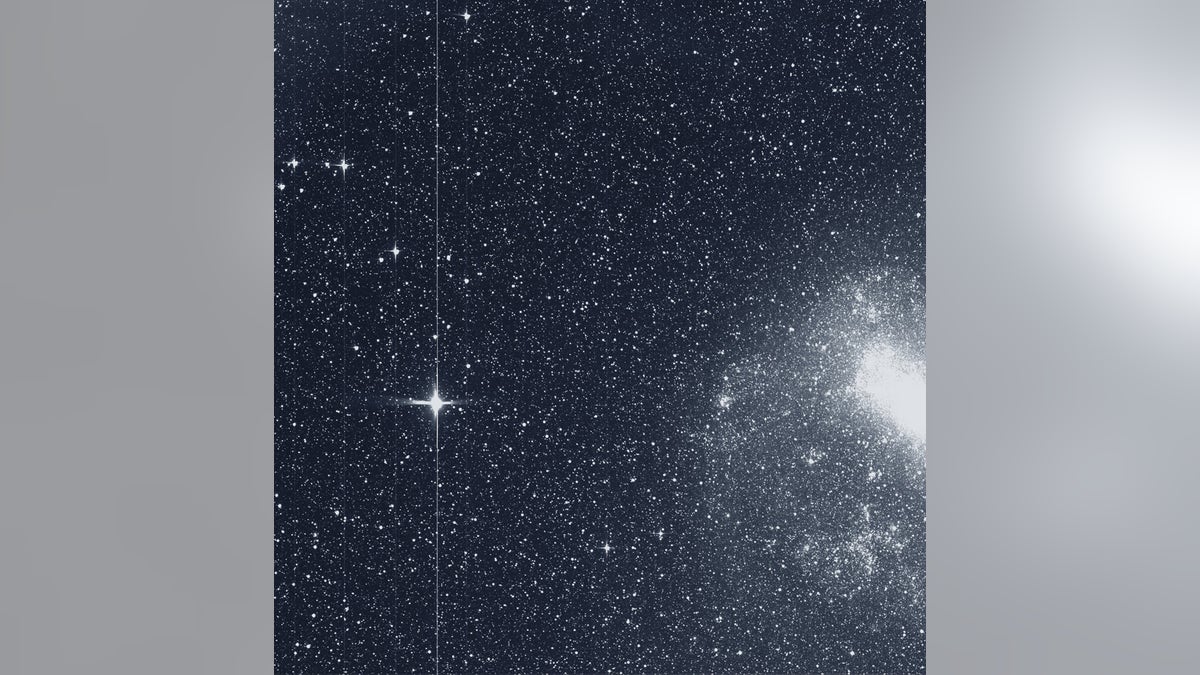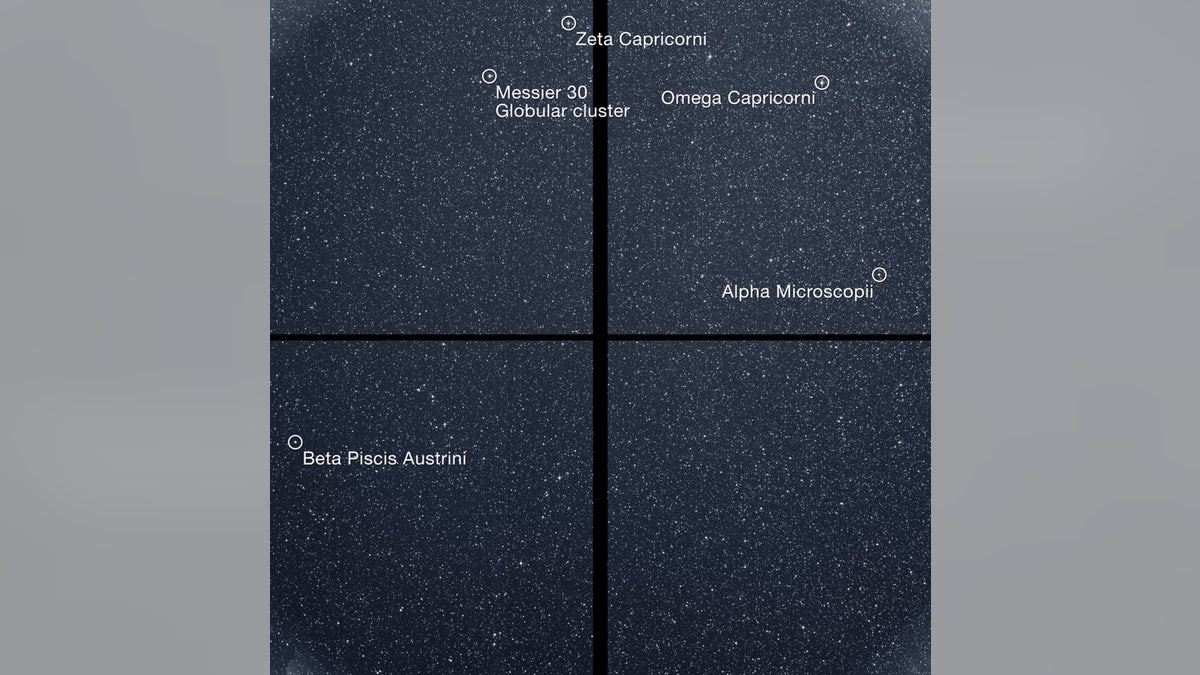
The Transiting Exoplanet Survey Satellite (TESS) took this snapshot of the Large Magellanic Cloud (right) and the bright star R Doradus (left) with just a single detector of one of its cameras on Tuesday, Aug. 7. The frame is part of a swath of the southern sky TESS captured in its “first light” science image as part of its initial round of data collection. (Credit: NASA/MIT/TESS)
NASA has unveiled the first images from the Transiting Exoplanet Survey Satellite (TESS), its $337 million alien-planet hunting satellite, and the results are nothing short of incredible.
Included in the first batch of pictures are the Large Magellanic Cloud and the bright star R Doradus, among several other planets and stars that could potentially be home to alien life.
“In a sea of stars brimming with new worlds, TESS is casting a wide net and will haul in a bounty of promising planets for further study,” Paul Hertz, astrophysics division director at NASA Headquarters, said in a statement. “This ‘first light’ science image shows the capabilities of TESS’ cameras, and shows that the mission will realize its incredible potential in our search for another Earth.”
NASA'S NEXT PLANET HUNTER IS READY TO FIND UNDISCOVERED WORLDS
In April, TESS was launched by a SpaceX Falcon 9 rocket and is expected to identify thousands of planets in our cosmic backyard, adding to the bounty provided over the past decade by NASA's Kepler Space Telescope.

The Transiting Exoplanet Survey Satellite (TESS) took this snapshot of the Large Magellanic Cloud (right) and the bright star R Doradus (left) with just a single detector of one of its cameras on Tuesday, Aug. 7. The frame is part of a swath of the southern sky TESS captured in its “first light” science image as part of its initial round of data collection. (Credit: NASA/MIT/TESS)
The planets discovered by Kepler are too distant and too faint for practical study. But those found by TESS should be close enough for mega telescopes in the future to detect any atmospheric signs of life.
The images were taken by TESS' four wide-field cameras during a 30-minute period on Aug. 7, NASA said. Included in the images are parts of 12 constellations, "from Capricornus to Pictor, and both the Large and Small Magellanic Clouds, the galaxies nearest to our own," NASA added.
The bright spots are two stars, Beta Gruis and R Doradus, which NASA said "saturate an entire column of pixels on the detectors of TESS’s second and fourth cameras, creating long spikes of light," due to the intense brightness.
“This swath of the sky’s southern hemisphere includes more than a dozen stars we know have transiting planets based on previous studies from ground observatories,” said George Ricker, TESS principal investigator at the Massachusetts Institute of Technology’s Kavli Institute for Astrophysics and Space Research in the statement.

The Transiting Exoplanet Survey Satellite (TESS) captured this strip of stars and galaxies in the southern sky during one 30-minute period on Tuesday, Aug. 7. Created by combining the view from all four of its cameras, this is TESS’s “first light,” from the first observing sector that will be used for identifying planets around other stars. Notable features in this swath of the southern sky include the Large and Small Magellanic Clouds and a globular cluster called NGC 104, also known as 47 Tucanae. The brightest stars in the image, Beta Gruis and R Doradus, saturated an entire column of camera detector pixels on the satellite’s second and fourth cameras. (Credit: NASA/MIT/TESS)
SPACEX BFR: FLY ANYWHERE ON EARTH IN UNDER AN HOUR
TESS' background
NASA's astrophysics director, Paul Hertz, said missions like TESS will help answer whether we're alone — or just lucky enough to have "the best prime real estate in the galaxy."
Still on the lookout from on high, Kepler alone has discovered more than 2,600 confirmed exoplanets. Even more candidates await confirmation.

The Transiting Exoplanet Survey Satellite (TESS) captured this strip of stars and galaxies in the southern sky during one 30-minute period on Tuesday, Aug. 7. Created by combining the view from all four of its cameras, this is TESS’ “first light,” from the first observing sector that will be used for identifying planets around other stars. Notable features in this swath of the southern sky include the Large and Small Magellanic Clouds and a globular cluster called NGC 104, also known as 47 Tucanae. The brightest stars in the image, Beta Gruis and R Doradus, saturated an entire column of camera detector pixels on the satellite’s second and fourth cameras. No object labels. (Credit: NASA/MIT/TESS)
The exoplanet count, from all observatories in space and on Earth over the past couple of decades, stands at more than 3,700 confirmed with 4,500 on the strong contender list.
About 50 are believed to potentially habitable. They have the right size and the right orbit of their star to support surface water and, at least theoretically, to support life.
WEIRD SOLAR SCIENCE: HOW NASA'S PARKER PROBE WILL DIVE THROUGH THE SUN'S ATMOSPHERE
Scientists speculate that the habitable or so-called Goldilocks zone — the distance from a star where it's neither too hot nor too cold to support life, but just right with the potential for liquid water at the surface — should be much closer to red dwarfs than it is in our own solar system. The orbits of any planets in these systems should be fairly short.
NASA and others stress that TESS will not look for atmospheric or other signs of life; it can't do that.
That all-important job will be left to Webb, the next-generation successor to the Hubble Space Telescope that's grounded until at least 2020, and even bigger observatories yet to come.

The Transiting Exoplanet Survey Satellite (TESS) captured this square of stars in the southern sky with its first camera during one 30-minute period on Tuesday, Aug. 7. Bright objects are labeled. (Credit: NASA/MIT/TESS)
If life, indeed, is detected out there — be it microscopic or some higher form — scientists like to think robotic explorers would be launched from Earth for closer inspections.
NASA project manager Jeff Volosin notes the technology for reaching these faraway worlds, or even communicating, doesn't yet exist.
"For me, just knowing they're there would be enough," Volosin told the Associated Press in April. "Just knowing that you're not alone."
Fox News' James Rogers and The Associated Press contributed to this report. Follow Chris Ciaccia on Twitter @Chris_Ciaccia




















